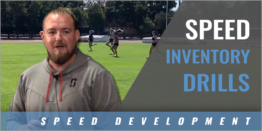|
Developing Speed: A Neurological Approach by Leo A. Settle Originally Published in Techniques Magazine - Official Publication of the USTFCCCA www.ustfccca.org
NEUROLOGICAL ADAPTATIONS Speed development, HRST, and plyometric training cause physiological adaptation in the neuromuscular junction. The junction between the terminal of a motor neuron and muscle fibers is known as the neuromuscular junction. The functions of the neuromuscular junction are to transmit signals from the motor neuron to the skeletal muscle fibers quickly and reliably, and to control skeletal muscle contraction, and therefore voluntary movement (Hong & Etherington, 2011). As an athlete's training increases, the distance between the motor neuron and muscle fibers shortens, allowing for increasingly rapid efferent electrical potential communication from the spinal cord. The shorter distance may allow athletes to produce higher force per foot-to-ground contact. In the adaptation of muscle fiber to physical training factors such as exercise intensity, duration, and frequency are crucial issues. Sport-specific training coupled with HRST is imperative to achieve performance improvement. Acceleration and sprinting performance can be significantly enhanced with an increase in the amount of motor unit recruitment during ground contact. Different types of motor units are randomly present in the skeletal muscle and classified into three types: Slow (I), fast (Ha) and fast subtype (lib). Motor units are activated when an athlete voluntarily contracts the demanded muscle for a task. The athlete's brain transmits an efferent signal from the spinal cord to the muscle to regulate the motor unit's recruitment. Motor units are generally recruited according to the size principle. Force production by a muscle is regulated by the numbers of fibers recruited for that particular activity. Endurance athletes recruit small motor units, type I muscle fibers, for low- intensity demands of aerobic training. Long-distance running (3-6 times a week) causes hypertrophy in type I fibers, but atrophy (size reduction) in type Ha and lib fibers, so this type of adaptation will result in reduction of muscle mass and strength. The associated training intensity is too low and the duration too high for power athletes. Athletes performing long-term endurance and aerobic activities use asynchronous motor unit firing. Their motor units are not recruited at the same time; like the pistons in an engine they rotate in and out to sustain the performance throughout the activity. Sprinters and explosive athletes recruit larger motor units, type Ha and lib muscle fibers because of the high-intensity demand. The training load requires near-maximum contraction to perform the exercises in a short time span so the high-intensity demand uses synchronous firing. Theoretically, synchronous firing means a high percentage of the type I, Ha and lib motor units are an contracted at once for maximum force production. Literature review suggests sprinters and strength athletes exhibit greater synchronization than untrained individuals, and HRST is linked to increase synchronization. The neurological ability to increase power without hypertrophy is crucial for optimal running speed. When the type I, Ha and lib motor units have a high percentage contract at once during an exercise, then maximum force of the muscle is generated. This will increase an athlete's strength-to-bodyweight ratio. Think of this analogy, an athlete wants to be like a light sport car with a powerful engine that allows it to maximize driving speed. The following strength standard ratios were outlined for world-class speed athletes by Dintiman, Ward, and Tellez (1997). The numbers indicated are one rep maximums relative to bodyweight. Multiply the athletes' strength standard number by their body weights (pounds) and the products are the goals. Example: Excellent power clean for a male weighing 165 LBS x 1.70 = 280 LBS IMPLEMENTING CONCURRENT TRAINING To qualify for the 2011 NCAA Track & Field Championships, an athlete was required to have a top-12 performance at either of two collegiate regional meets. The 12th-best qualifying performance at the 2011 NCAA West Regional Track & Field Championships for the Men's 100 meters was 10.52 seconds. If an athlete's personal best (RB.) is 10.65 seconds, and he improves by 2.3 percent, his new RB. performance will be 10.41 seconds. According to the literature, increasing his strength in the squat would enhance his chances of qualifying for the NCAA Championships. ABSOLUTE SPEED SESSIONS The volume of absolute speed training and resistance training sessions is crucial and can be detrimental if prescribed in large amounts. The type Ha and lib muscle fibers are highly fatigable, and if an athlete overloads these fibers, the onset of over training is plausible. Absolute speed is developed with relatively low volume of 95-100 percent intensity with the emphasis on quality, not quantity. Two main objectives to consider are: If the goal of a speed development program is to maximize short distance/sprinting speed, the training sessions should be of low volume and high intensity (longer rest periods aid in accomplishing this), and performed under conditions where fatigue is not a factor. The training distance should be 40-60 meters or flying 30 meters. TESTING YOUR SPEED, STRENGTH, EXPLOSIVENESS AND POWER: THE MAX JONES QUADRATHLON The four components of the Quad test: Standing Long Jump: Athletes stand at the edge of the long jump runway facing the sand pit with body erect, and then aggressively lower hips with controlled momentum and bending 90 degrees into a squat position, they explosively jump in a horizontal direction into the sand pit, using both feet for furthest distance from take-off point. Measure and record in meters the distance hopped from the starting line to the first body impression in the sand pit. Standing Triple Jump: The coach places a fixed piece of tape on the runway for the starting line about 7 to 8 meters (females 6-7 meters) from the pit. Athletes stand on the long jump runway facing the sand pit, with body erect, aggressively lower hips with controlled momentum and bending into a squatting position, they explosively jump in a horizontal direction hopping on one foot, alternating to another hop on the opposite foot, and landing in the sand pit. Measure and record in meters the distance hopped from the starting line to the first body impression in the sand pit. Thirty-Meter Sprint: The automatic timing system may be used to record 30-meter acceleration times. The most popular automatic timing system comes with a touch pad: 4 infrared eyes with built-in transmitters, tripods for the transmitters and a handheld display that records the time of the test to 0.01 second. The touch pad is placed on the starting line, and two transmitters on tripods at the finish line of the 30 meter path. The athlete assumes a three-point starting position, or comes out of starting blocks with one hand on the touch pad. The system starts immediately once the subject accelerates, and the time appears on the handheld display once the transmitters' infrared beams are broken. A stopwatch may be use as an alternative. Overhead Back (Men: 16lbs; Women: 4kgs): Athlete stands on the shot put ring toe board with feet shoulder width apart, facing the back of the ring (away from the throwing sector). The athlete holds the shot with both hands and aggressively lowers hips with controlled momentum, bends into a squatting position, and then explosively extends the legs (moving upward and backwards) throws the shot backward and into the throwing sector. Measure and record in meters the shot impression to the back edge of the toe board. If equipment is not accessible for administering the Quad Test, then the alternative would be plyometrics. Coaches can be creative with plyometric training using a variety of exercises including: bounding, power skips, stadium double legs hops and box jumps. Remember, the key is maximum effort with a low volume (20-50 jumps total a session is recommended). FATIGUE Fatigue is defined as a decline in muscle performance associated with the given activity. The human nervous system is complex, and research into fatigue is still in the early stages. Currently, researchers have fatigue theories with debate over which are the primary causes and which have little effect. Fatigue at the point of origin is known as central fatigue. Since the CNS originates in the motor cortex, it may affect emotional state motivation. Imbalance of athletes' training volume and intensity can lead to CNS fatigue. This fatigue can happen when the athlete is overloaded with many repetitions of sprinting or near-1RM lifts. CNS fatigue does not affect performance muscles directly, but it can reduce power output. Peripheral nervous system (PNS) fatigue is localized in the trained muscle. For example, in a 100-meter full-effort sprint, PNS fatigue is likely to occur in the hamstring and hip extensor muscle groups. Muscle activation of maximum and sub- maximum efforts causes change in their properties and micro tears. PNS fatigue is also induced from the accumulation of phosphate in the muscle. This accumulation contributes to insufficient release of calcium for the demanded work load(Allen, 2004). The byproduct is also known as lactic acid. PNS fatigue is acute, and should not produce long lasting fatigue. ACTIVE RECOVERY DAY PRACTICAL APPLICATIONS SUGGESTED TRAINING WITH COMPETITION ON SATURDAYS Transition (20-30 meters) - The athlete gradually rises from acceleration to a tall and slightly forward leaning position. These training sessions may be implemented once a week on Mondays or Wednesdays. Perform these sessions during early to competition season. Speed Maintenance / Speed Endurance (80-150m) - This phase is a gradual decline of velocity due to muscle PNS fatigue. The athlete that fatigues the least appears to be running faster to the finish line. These training sessions may be implemented after starts, Tuesday, or Thursdays. Lifting Program - The lifting sessions may be implemented two days a week. REFERENCES Bruce-Low, S., Smith, D. (2007) Explosive Exercise in Sports Training: A Critical Review. Official Journal of Exercise Physiology online, 10 (1), 21-33 Dintiman, G., Ward, R., & Tellez, T. (1997). Sports Speed. Champaign, Illinois: Human Kinetics Books. Dunn, G.D., and McGill, K. (2003) The Throws Manual, Third Edition. Mountain View, CA: Track and Field News Press Hong, I. H. and Etherington, S. J. (2011) Neuromuscular Junction. eLS Warpeha, J. (2007) Principles of Speed Training. National Strength and Conditioning Association's Performance training Journal, 6 (3), 6-7 Young, W.B. (2006) Transfer of Strength and Power Training to Sports Performance. International Journal of Sports Physiology and Performance, 1, 74-83 Leo Settle is an assistant Track & Field coach at the University of Texas at El Paso overseeing the Men's Sprints, Hurdles and Jumps for the Miners. |
|
|








